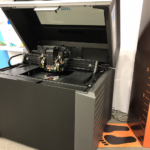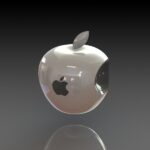

Earlier this week we published a very interesting article about the intentions of Google and 3D Systems to print “millions, and hopefully billions” of smartphone modules for Google’s Project Ara. Project Ara has received a ton of media attention over the last several months, as Google sets out to change the way smartphones are made and sold. Having said this, I think the bigger story within the story, is the fact that 3D Systems will be using an entirely new mass manufacturing system, which will rely almost solely on 3D printing.
3D Systems may be about to single-handedly revolutionize the manufacturing industry, by integrating a new system, capable of mass production, via additive manufacturing. We all know that traditional 3D printers, even the large scale quarter million dollar machines, are painstakingly slow. Up until now, unless you are mass producing only a few hundred small products, 3D printers are better left for rapid prototyping.
There are tremendous benefits to 3D printing, mainly the fact that each print a machine makes can be totally different than its last. All the while, there is no need to change out equipment, teach production line employees new techniques, or reprogram the movements of robotic arms. If manufacturers could just overcome the problem of speed, the entire industry would be turned upside down.
This is where 3D Systems is about to step up to the plate. They are working on a highly sophisticated, mass manufacturing system, which relies on high speed 3D printers. Such a system is so productive that it will be used in the manufacturing of millions or even billions of Google Project Ara smartphone modules.

So how has 3D systems been able to overcome the downfalls of additive manufacturing? According to the company, their latest technique removes the “reciprocating platform,” used my most 3D printers today. Current 3D printers work in a way which allows the build platform and print head to move in tandem. Because of this, there are many abrupt stops, or reductions in speed during the print process, as the machine needs to change its direction of print. Imagine if a typical FDM based 3D printer was able to print in a straight line only, for great distances. Think about how many mm/sec it could print compared to a printer which needs to print a cubed object. The printer making the cube will need to change its print direction every few inches, meaning it needs to come to almost a complete stop, and then re-accelerate.
3D Systems has realized this, and has come up with a new “racetrack architecture,” which will allow a 3D printer to print in a not stop flow, at extremely high speeds. In a recent blog post about their Project Ara intentions, 3D Systems explained, “For more productive print rates (of millions and hopefully billions of units), we’re creating a continuous motion system around a racetrack architecture that will allow the module shells to move in a continuous flow with additional “off ramps” for various finishing steps, including inserts and other module manipulations.”
I envision this new systems as sort of a production line setup, with prints moving off a conveyor belt, onto a new area once certain layers of material are placed down. The system could utilize dozens, or even hundreds of print heads, all printing in a specific direction for hundreds of feet, at high speeds, along a specific conveyor belt. Once a new material, perhaps even a conductive material, is needed, the specific prints are removed from conveyor belt A, and are placed on conveyor belt B, where that new material is printed.
Such a system could drastically change the way manufacturing facilities operate. No longer would companies require a specific manufacturing facility for specialized parts, or even have a need for their own facility at all. Instead, an entire facility could be transformed from producing tiny tweezers, to automobile engine casings within minutes, via the software which operates the printers.
The system which 3D systems is using for Project Ara will likely be revealed in the near future. If it’s anything like they claim it to be, you can rest assured that hundreds of manufacturers will soon be very interested. The third industrial revolution may soon be upon us. What do you think? Discuss the the possibility of 3D printing within mass manufacturing at the 3DPB.com Forum.
If you're looking to get architectural 3D animation in the USA, our service provides an exceptional way to bring your architectural concepts to life through dynamic, immersive visuals. Through our platform, you can easily request high-quality 3D animations that showcase your designs in motion, offering a detailed view of your project from multiple angles and perspectives. Whether it's for a real estate development, a commercial building, or an urban planning project, our expert team ensures that every detail is captured in a visually compelling animation.
Through our website, you can seamlessly get architectural 3D animation tailored to your project’s specific needs. With our help, you can offer potential clients or investors an engaging experience that goes beyond static images. By integrating CGI animations with real-world settings, lighting, and textures, our team creates a lifelike experience that allows your audience to interact with your project as though it were already built. This service is perfect for presenting complex designs in a clear, visually attractive way that stands out in the competitive architectural market.




